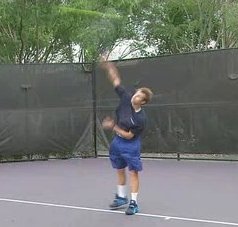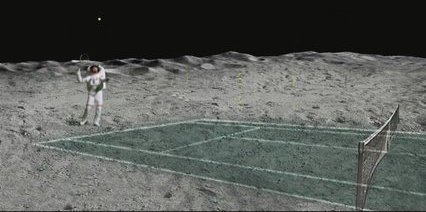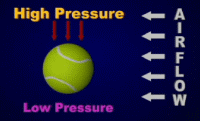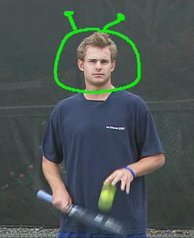|
Humans are heading back to the Moon. Tennis,
anyone?
by Phil West and Dr Tony Phillips
They call him the "Rocket
Man." Tennis pro Andy Roddick holds the world's record for
fast serves: 155 mph. By the time opponents realize where the ball
is going, very often, it's already gone. Ace! His groundstrokes
are like rockets, too.
Believe it or not,
this can be a problem. Balls hit so hard want to go long, flying
straight out the back of the court. Out! It's hard to win a game
that way.
So what do you do when
you're so powerful? Roddick has a trick up his sleeve: topspin.
By hitting the ball obliquely (at a slant), he causes it to spin.
Topspin makes the ball curve downward. Instead of going out, it
drops neatly into play on the other side of the net.

Andy Roddick
serves a 100+ mph blur
|
Now the Rocket Man
is wondering, "What if the US Open were played on the Moon?
Would topspin do me any good?"
It's a perfectly reasonable
question. In 2004 when President Bush set out the nation's Vision
for Space Exploration, he declared "human beings are headed
into the cosmos." He never said, except for the tennis players.
Where people go, sport follows. Decades from now, tennis might be
a popular pastime on the Moon.
Picture this: Two space-suited
athletes stare at each other across the net of a tennis court drawn
in moondust. Their own reflections stare back from the faceplate
of the opponent. Overhead, the sun is bright, the sky is black and
Earth looks absolutely beautiful; it's a crescent today.
One player tosses the
ball up … up … up. Smash! Soundlessly, a 100+ mph serve
glides across the net, long. Another serve, long. And another, long.
Groundstrokes go long, too.
Something's wrong.
On the Moon, topspin doesn't work.
Actually, the ball
spins just fine, but spinning doesn't make it curve downward. The
Moon has no air, and spinning balls only curve when they're flying
through an atmosphere. (Note: Gravity causes balls to curve downward,
too, but not enough to rescue every shot.)

Credit: Paula Vargas and Terry Longbottom
of NASA/JSC.
An artist's
concept of Moon tennis.
|
Physicists call this
the Bernoulli Effect: Air pressure on one side of a spinning ball
is higher than it is on the other side. High pressure pushes the
ball toward low pressure - hence the curve. Swiss physicist Daniel
Bernoulli wrote down the equations describing this curious phenomenon
in the 18th century, setting the stage for Andy Roddick's devastating
power game almost 300 years later.
The Bernoulli Effect
is very important in sports. In baseball, it lets pitchers throw
curveballs. In tennis and ping pong, it helps players ace their
serves. In golf, it's responsible for the dreaded slice.
Aside: Apollo 14 astronaut
Al Shepard became the first extraterrestrial golfer on February
6, 1971, when he tried hitting some balls on the Moon. His club
was homemade, consisting of a 6-iron attached to the end of a geology
tool handle. "Unfortunately, the suit is so stiff, I can't
do this with two hands, but I'm going to try a little sand-trap
shot here," said Shepard. One shot, remarked mission control,
"looked like a slice." Shepard countered "Straight
as a die!" In fact, the ball rolled just 2 or 3 feet. Later,
Shepard did get off a good shot which famously went "for miles
and miles and miles." Practice makes perfect, especially on
the Moon.

The Bernoulli
Effect
|
Moon tennis is going
to differ from Earth tennis in many ways. For example: In the Moon's
lower gravity, only 1/6th Earth's, lobs will fly six times higher
and hang six times longer. Thirsty? Hit a lob. While it's in flight
you can go get a drink of water.
Here on Earth we have
clay courts and grass courts. On the Moon there will be dust courts.
The surface affects the style of play: clay is a slow surface, while
grass is faster and prone to crazy bounces. A dusty surface will
probably be slow, until it packs down a bit.
Moondust adds an interesting
twist to tennis. For one thing, moondust is extremely dry and insulating,
and thus prone to static cling (like a crackling sock pulled out
of the dryer). Balls hit into this material over and over will soon
gather a layer of electrified dust. Want to shock your opponent?
Smash the ball straight at him!

Andy Roddick
ponders tennis
on other worlds
|
There's more: When
a ball bounces off a mooncourt, it's going to kick up a little dusty
plume. Spin the ball just right and you could send that dust jetting
toward your opponent, craftily blinding him. Topspin, or in this
case, backspin, might come in handy after all.
And don't forget the
spacesuits. On Earth, players wear shorts and light shirts. On the
Moon, they'll be climbing into a bulky full-body pressure suit.
As Apollo astronauts discovered, you don't really "run"
in a 1/6-g moonsuit, you "bound," hopping around like
Tigger of the Hundred Acre Wood. A player might spend more time
off the ground than on it. ("Footwork!" cries your tennis
coach. Footwork? How can you have footwork when your feet don't
touch the ground? Old-fashioned strategies might not work on the
Moon.)
Furthermore, joints
at the elbows, knees and especially shoulders of spacesuits are
less flexible than real human joints. Overhead serves are going
to be mighty difficult. Sorry Andy! Forehand or underhand serves,
legal in Earth tennis, might be required on the Moon. Meanwhile,
the backhand stroke could become extinct: it's tough to reach across
the body of a turgid spacesuit.
Eventually, special
suits might be manufactured for moon tennis, designed to allow overhand
serves, backhand shots, and normal running. The dimensions of courts
could change, too, probably made bigger to accommodate no-Bernoulli
serves and low-gravity volleys.
Low gravity. No topspin.
Bulky spacesuits. Moon tennis is going to be different. Says Roddick,
"…that might be kind of cool!"
|
